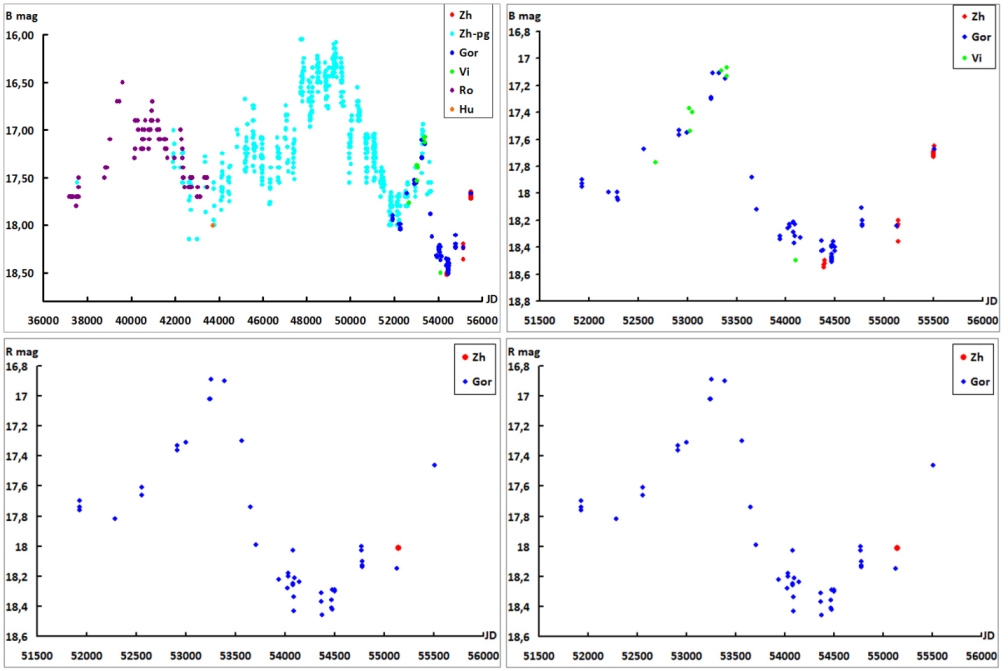"Peremennye Zvezdy",
Prilozhenie,
vol. 11, N 11 (2011)
Prilozhenie,
vol. 11, N 11 (2011)
V532 in M33
A. Zharova#1, V. Goranskij#1, O. N. Sholukhova#2, S. N. Fabrika#2
#1. Sternberg Astronomical Institute, Moscow State University, Moscow, Russia;
#2. Special Astrophysical Observatory (SAO), Russian Academy of Sciences, Nizhnij
Arkhyz, Russia
#2. Special Astrophysical Observatory (SAO), Russian Academy of Sciences, Nizhnij Arkhyz, Russia
Received: 8.12.2010; accepted: 24.03.2011
(E-mail for contact: alla@sai.msu.ru)
| ||||||||||||||||||||||
Remarks: |
| V532 (M33) was discovered by Romano (1978). Romano suggested that this blue star
belonged
to Hubble–Sandage variables.
The Moscow collection of plates of the л33 galaxy contains 678 plates taken with a wide-field telescope of the Crimean Laboratory of Sternberg Astronomical Institute (the 50-cm Maksutov camera). The plates cover a field of 3.5 x 3.5 degrees. The limiting magnitude of these plates is about 19. All the plates of this series are in the B photometric band. Plates of the same series, which had been shorter at that time, were earlier used to study the star by Sharov (1973, 1990). We have re-estimated the old plates with new standard stars. The new BVR photoelectric standards obtained by V.P. Goranskij with the 1-m Zeiss telescope in SAO were used for CCD and photographic observations. The finding chart shows the standard star used for CCD photometry (15.40B, 14.42V, 14.51R). The typical uncertainty of our photographic estimates is 0.1 mag (0.2–0.5 mag for stars fainter than 17). Only 645 of 678 plates were actually used, the star being below the plate limit for the rest of the plates. Our CCD observations of the star started in 2001. The mean uncertainty of the CCD observations is about 0.01–0.02mag. V532 was observed with the 60-cm Zeiss telescope equipped with an Apogee AP47 camera and a wide-field telescope (the 50-cm AZT-5 Maksutov camera) equipped with a Pictor camera (the Crimean Laboratory of Sternberg Astronomical Institute) as well as with the 1-m Zeiss telescope of Special Astrophysical Observatory. Thus, the combined data set used for our analysis consists of 645 photographic observations (1973–2005) and of multi-band BVRc CCD observations (2001–2010; 75 B-band, 79 V-band, 47 R-band measurements). We also analyzed the data by Romano (1978). These photographic estimates are from 104 blue plates obtained with the 67-cm Schmidt telescope in Asiago in 1960–1977. Also used were nine B-band and nine V-band photometric measurements from Viotti et al. (2006) and from Humphreys (1980). They are in good accordance with our data. In general, the long-term spectroscopic and photometric history of the variable seems to have followed the typical behavior of S Dor variables. V532 exhibits irregular light variations with different amplitudes and time scales. Generally, the star shows large and complex wave-like variations, the duration of the waves amounting to several years. Four maxima of the waves were observed. At present, V532 is at 17.7 B, becoming brighter. |
| References: |
| Humphreys, R.M., 1980, Astrophys. J., 241, 587
Romano, G., 1978, Astron. Astrophys., 67, 291 Sharov, A.S., 1973, Perem. Zvezdy, 19, 3 Sharov, A.S., 1990, Soviet Astron., 34, 364 Viotti, R.F., Rossi, C., Polcaro, V.F., et al., 2006, Astron. Astrophys., 458, 225 |
Light Curve
Light curves of V532 in B (photographic or CCD), V, and R bands. Zh – Zharova, Gor – Goranskij, Ro – Romano, Vi – Viotti, Hu – Humphreys. Finding Chart 
5'x5' Data Source |